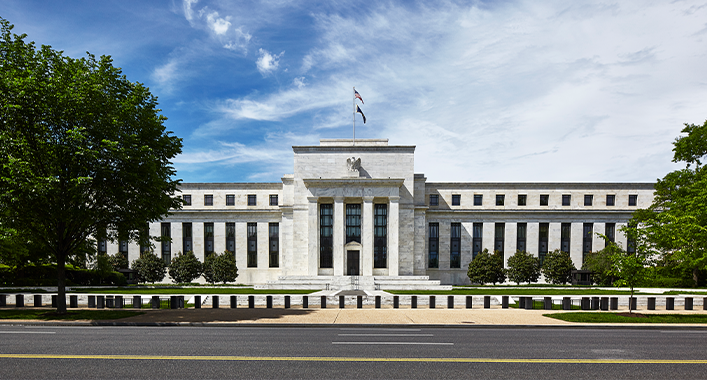If the Fed has its way, this cycle would be the fourth outside of a recession.
So far, evidence of economic stability abounds. For example, the unemployment rate eased slightly from 4.3% in July to 4.2% in August. This figure is higher compared to the 50-year low of 3.8% achieved last year but does not indicate a sharp turn in the labour market. The country also continues to hire, with 142,000 jobs added in August — lower than expected but still positive.
Meanwhile, US gross domestic product, adjusted for inflation, rose at a 3.0% annual rate in the second quarter of 2024, according to the Commerce Department. The Atlanta Fed’s GDPNow model estimate for third quarter GDP growth is 2.5%, as of 9 September.
Economic growth appears to be broadly moderating toward the long-term potential growth of the US, which our economists estimate to be just below 2%, according to Atluri. As growth slows, there is a higher risk that any shock could push the US economy closer to a recession. “I believe the economy is slowing, but not weak. We are still growing at a healthy pace. Over the next year, I expect growth of around 2%, which is at or above potential,” he adds.
The “rolling” recession phenomenon, marked by various sectors of the economy going through business cycles at different rates, has helped keep the overall economy on solid ground, Jones says. This is true even as companies such as budget-friendly retailer Dollar General sound the alarm on weaker spending by their core customer base of lower income consumers.
“When companies talk about slowing demand, it’s because they’re seeing weaker revenue growth,” Jones explains. “Part of that is because inflation is coming down, especially in goods versus services where pricing tends to be stickier. In aggregate, inflation-adjusted personal consumption expenditures have continued to grow.”
The upside of falling rates
Another reason for economic optimism? High-income consumers remain confident. “They have jobs, stock prices are up, their homes have been rising in value, and they’ve been taking trips to Europe,” Jones says. The S&P 500 Index is up nearly 18% year to date through 18 September.
“Lower rates should help some of the more interest rate sensitive sectors of the economy like housing, autos, consumer lending and the battered commercial real estate sector. These positive impulses could offset the gradual slowing in the labor market to maintain the conditions for an economic soft landing,” Atluri adds.
Yet a swift recovery for big-ticket, one-off purchases such as homes may be unlikely. “Anyone that had an inkling to move closer to family or take advantage of near-zero interest rates moved during the pandemic,” Jones says. “Inventory of homes for sale remains very low, and house prices are at an all-time high. Thus even with slightly lower rates, affordability remains a challenge, and home owners with 3% mortgages will still be reluctant to move.”
Against this backdrop, Jones sees opportunities in companies that offer steady earnings potential through most economic cycles but aren’t considered purely defensive. For example, earning potential for a payroll company like Automatic Data Processing (ADP) tends to increase alongside economic growth and has been less impacted by downturns than more cyclical industries because of its historically recurring revenue stream.
The same goes for certain health care companies, including drug distributors and some medical technologies, because demand for their products tends to remain steady. Health care companies overall have been slow to normalize post-pandemic. Election-related regulatory oversight has also weighed on valuations, making them attractive.
Megatrends such as artificial intelligence remain relevant in any business cycle. “I think AI is the biggest technology revolution since the internet, and it will be a huge source of efficiency gains for companies,” Jones says. That in turn could herald a strong period of overall growth — not unlike technology powered economic growth of the 1990s. Exactly when these efficiency gains could happen is difficult to pinpoint, and there could be pockets of stock market volatility along the way, but Jones believes “the potential is compelling.”
Bonds are back
What is clear is that rate cuts will likely lead to lower cash yields than the 5.0% or so money markets have offered to date. If the Fed cuts rates as much as markets expect, cash yields could quickly drop to under 3.0% over the next year. Faced with the prospect of lower returns on cash, investors have begun to pile into high-quality bond funds in 2024.
The current environment offers decent return potential for fixed income. “Inflation is falling, and the Fed has pivoted its attention to support growth, which is usually an attractive time for bonds,” Atluri says.
With inflation nearer to a 2% target, the Fed has ample room to cut rates even faster — more than current market expectations — should a growth shock occur and recession risk grow. Historically, bonds have been at their strongest in periods of rate cuts since bond prices rise as yields fall. Average returns for the Bloomberg US Aggregate Index have sharply outpaced cash proxies on average in rate-cutting periods between September 1984 and September 2024.









